|
| |
|
Non-skid
or the fine art of staying with your board
without giving up too much skin |
| While surfers use
prodigious amounts of wax to stay connected with their boards, windsurfers
(who generally do not belly-flop on their boards) can use the much-less
messy non-skid as provided by mildly abrasive matter such as sand, salt,
sugar, Urethane dust, or - preferably - Acrylic dust. While all of the
former have been used in the past, the Acrylic dust has proven to be the
longest-lasting and most aesthetically pleasing. As well, it does not
attract ants :) In order to affix these mildly
abrasive agents, a "glue" needs to be employed, which may be paint or resin.
One popular product, Re-Dek, combines such "glue" - a
clear Acrylic paint - with the bumpy bits - Acrylic dust. While very
convenient - just stir vigorously and roll on - it does not last overly long
due to the soft nature of the Acrylic paint; nor is it particularly
non-skid, since the abrasive bits are embedded in soft paint. Also, the
solvent in the Acrylic paint tends to muck up graphics and lift off stickers,
if applied too generously.
Most production boards these days come with Acrylic
dust applied into clear Epoxy or LP paint, while most custom boards have the
Acrylic dust applied onto a UV-resistant Epoxy resin. The latter outlasts
the former about 2:1, which is why I use Epoxy resin. |
| The worst part of applying
new non-skid to an older board is to get rid of the old stuff. Just
plastering over the old won't fly, since it would add much weight (at least
1/2 lb for a 9ft board), and would stick only as good as the original
non-skid - which may not be very good any more. So off it comes, with
sandpaper if an old factory job, or a scraper, if a retro Re-dek job. It is
hideous work, gobbling up sandpaper, while always running the risk of going
through the color coat and having to touch that up in the bargain. |
| This lovely V2Max had been attacked
with much enthusiasm and little care or skill, taking much paint off
together with the original non-skid, then slopping on Re-Dek with a
broom or such.
It came to me pug-ugly as well as slippery. |
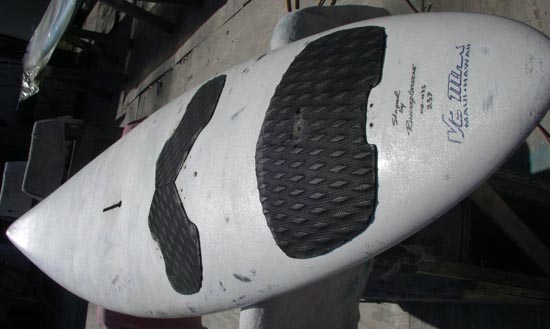 |
|
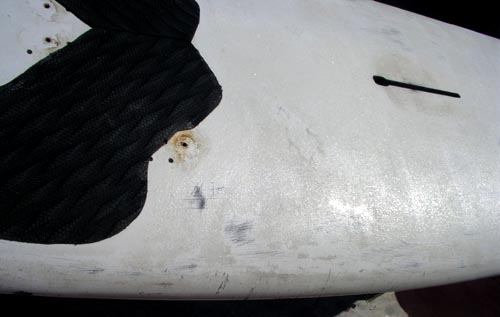 |
Roller marks from the Re-Dek job are
clearly visible, as are shiny bare patches, where the Re-Dek departed
due to poor surface prep (insufficient sanding) |
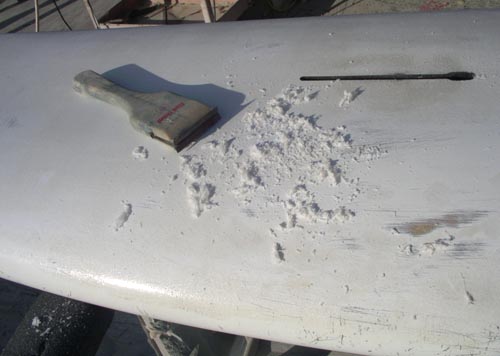 |
Taking old Re-Dek off is best
accomplished with a scraper - sharpen it frequently with a fine file and
go easy, so as to not take off the underlying color coat! |
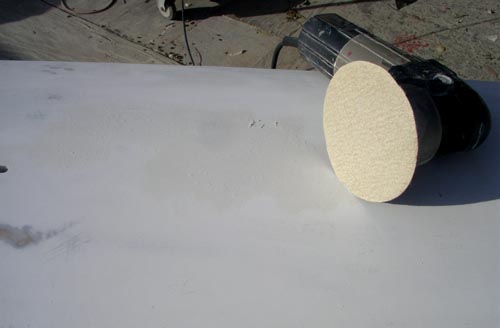 |
Finish off by sanding - 80 grit open
paper in a random-orbital sander works best to finish stripping the old
non-skid and even things out. Feather paint edges with 120 grit paper,
then finish things off with 220 grit, to make the new paint look good. |
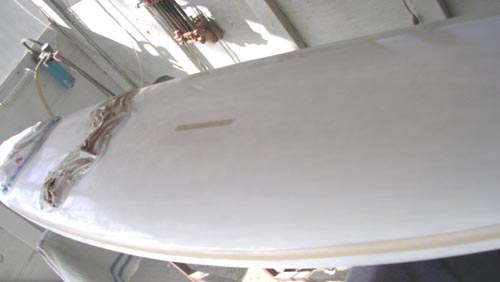 |
If you spray the new paint, the padz
need to be masked off, as well as the edge of the non-skid on the rails,
and vent fixture and mast box. |
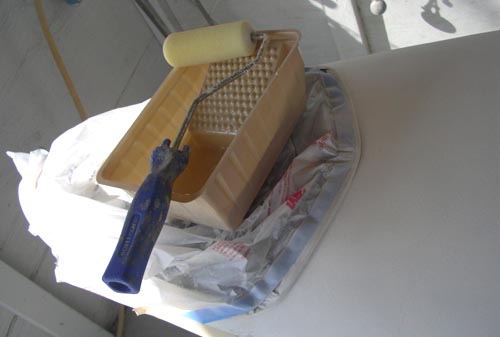 |
Mix the UV-resistant Epoxy, and
spread it out in a roller pan to buy working time. A foam roller with
round ends works best to apply the Epoxy. If you roll it on vigorously
in a criss-cross pattern, 50cc of Epoxy will cover the deck of a 9fter,
adding minimal weight, while gluing the non-skid dust very nicely. |
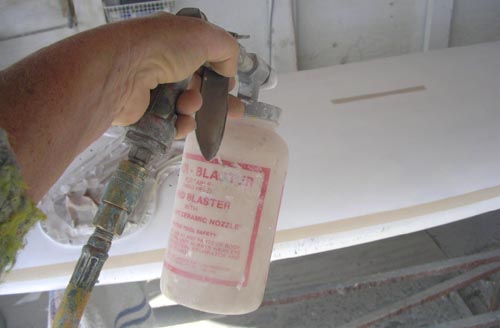 |
Once the Epoxy is evenly applied, I
like to mist on the Acrylic dust with a sandblaster at about 50psi.
First, I aim somewhat above the board, to let the dust settle down
without pressure, then check for shiny (i.e. bare) spots, and go over
the whole deck once more, gently blowing directly at it.
Obviously, you could in a pinch apply the dust with
a flour sifter, or even a salt shaker. |
|
| Pull all tape before the Epoxy
starts to tack, let cure overnight. Then blow off excess dust, and rinse
the board to remove loose bits on the surface.
The Acrylic "Deck Dust" comes in fine, medium and
coarse grits.
The "fine" will closely match most production
boards, and be nicely non-skid.
The "medium" is for those hardy souls who sail
bare-footed and want extra grip. It will give you "road rash" and leave
your wetsuit fuzzy.
The "coarse" has chunks the size of raw sugar.
One customer who demanded "super extra grippy" came back a few days later with
much skin missing from his ankle, so - personally - I think the "coarse"
is overdoing things just a little. |
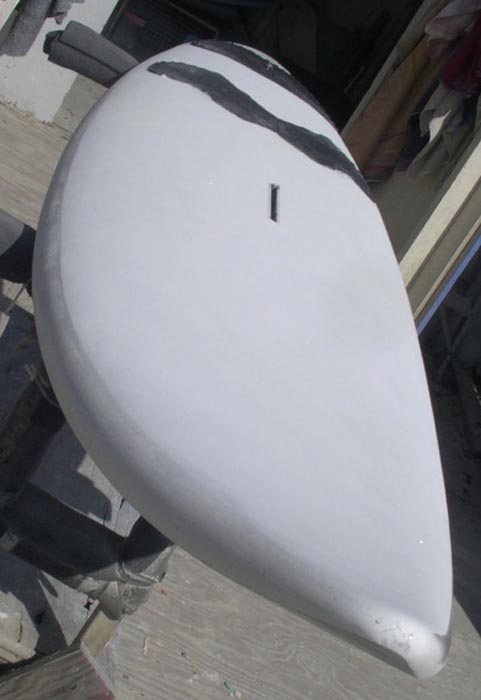 |
|
|
return to Repair Menu |
|